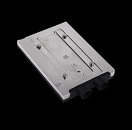- Joined
- Oct 9, 2007
- Messages
- 47,301 (7.52/day)
- Location
- Hyderabad, India
| System Name | RBMK-1000 |
|---|---|
| Processor | AMD Ryzen 7 5700G |
| Motherboard | ASUS ROG Strix B450-E Gaming |
| Cooling | DeepCool Gammax L240 V2 |
| Memory | 2x 8GB G.Skill Sniper X |
| Video Card(s) | Palit GeForce RTX 2080 SUPER GameRock |
| Storage | Western Digital Black NVMe 512GB |
| Display(s) | BenQ 1440p 60 Hz 27-inch |
| Case | Corsair Carbide 100R |
| Audio Device(s) | ASUS SupremeFX S1220A |
| Power Supply | Cooler Master MWE Gold 650W |
| Mouse | ASUS ROG Strix Impact |
| Keyboard | Gamdias Hermes E2 |
| Software | Windows 11 Pro |
After developing the compact, very successful Alphacool HDX M.2 SSD cooler, Alphacool is now expanding its product range with the Eisblock HDX-2 and HDX-3 coolers. Both coolers come with a 4x PCIe card, on which the cooler and SSD are mounted. This has many advantages over mounting directly to the motherboard.
Cooling can be difficult on a motherboard due to space constraints and the location of the graphics card, which is often mounted directly above or beside the motherboard. A PCIe card and cooler give you lots of room to set up a good cooling solution. But why do you need to cool your M.2 SSD? When an M.2 SSD is used continuously and for substantial data transfers, it can heat up so strongly that the drive slows itself down and decreases its performance significantly. This can happen after even a few seconds. The only way to solve this problem is with a good cooling solution.





Another advantage is the included 4x PCIe cards, which provide the SSD with a maximum data transfer rate of around 3900 MB/s. 2.5" SSDs are limited to around 640 MB/s over a SATA connection, and many M.2 interfaces on motherboards are only connected to 2x PCIe - half the bandwidth of the HDX-2 and HDX-3 card.
The HDX-3 water block is a complete cooler that can easily be connected to any cooling loop with its G1/4" connectors. The water block itself is made of nickel-plated copper, and the lid is made of a single acetal block. Water flows over the entire SSD and ensures outstanding cooling performance.
With its massive aluminium radiator block and backplate, the HDX-2 cooler offers a large cooling surface for dissipating heat. The thick cooling fins give the Eisblock HDX-2 cooler a classic massive-yet-elegant design.
Both coolers come with thermal pads for one-sided and double-sided M.2 SSDs, making both coolers compatible with all M.2 PCIe SSDs.
View at TechPowerUp Main Site
Cooling can be difficult on a motherboard due to space constraints and the location of the graphics card, which is often mounted directly above or beside the motherboard. A PCIe card and cooler give you lots of room to set up a good cooling solution. But why do you need to cool your M.2 SSD? When an M.2 SSD is used continuously and for substantial data transfers, it can heat up so strongly that the drive slows itself down and decreases its performance significantly. This can happen after even a few seconds. The only way to solve this problem is with a good cooling solution.





Another advantage is the included 4x PCIe cards, which provide the SSD with a maximum data transfer rate of around 3900 MB/s. 2.5" SSDs are limited to around 640 MB/s over a SATA connection, and many M.2 interfaces on motherboards are only connected to 2x PCIe - half the bandwidth of the HDX-2 and HDX-3 card.
The HDX-3 water block is a complete cooler that can easily be connected to any cooling loop with its G1/4" connectors. The water block itself is made of nickel-plated copper, and the lid is made of a single acetal block. Water flows over the entire SSD and ensures outstanding cooling performance.
With its massive aluminium radiator block and backplate, the HDX-2 cooler offers a large cooling surface for dissipating heat. The thick cooling fins give the Eisblock HDX-2 cooler a classic massive-yet-elegant design.
Both coolers come with thermal pads for one-sided and double-sided M.2 SSDs, making both coolers compatible with all M.2 PCIe SSDs.
View at TechPowerUp Main Site



